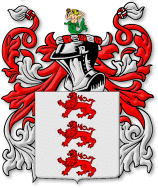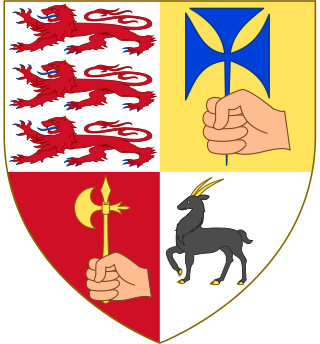McMahon, also spelt MacMahon, were different Middle Age era Irish clans. Their name is derived from the Gaelic MacMathghamhna meaning 'son of the bear'. According to historian C. Thomas Cairney, the MacMahons were one of the chiefly families of the Dal gCais or Dalcassians who were a tribe of the Erainn who were the second wave of Celts to settle in Ireland between about 500 and 100 BC.

Knappogue Castle is a tower house, built in 1467 and expanded in the mid-19th century, located in the parish of Quin, County Clare, Ireland. It has been restored and is open to guided tours.
O'Dea, is an Irish surname derived from Deághaidh, the name of a tenth-century clan chieftain. According to historian C. Thomas Cairney, the O'Deas were one of the chiefly families of the Dal gCais or Dalcassians who were a tribe of the Erainn who were the second wave of Celts to settle in Ireland between about 500 and 100 BC.

The Dalcassians are a Gaelic Irish clan, generally accepted by contemporary scholarship as being a branch of the Déisi Muman, that became very powerful in Ireland during the 10th century. Their genealogies claimed descent from Tál Cas. Their known ancestors are the subject of The Expulsion of the Déisi tale and one branch of their blood-line went on to rule the petty kingdom of Dyfed in Wales during the 4th century; probably in alliance with the Roman Emperor Magnus Maximus.

The name McInerney is of noble Irish origin where it is found in the modern Irish form of Mac an Airchinnigh and in the old and literary forms of Mac an Oirchinnigh and Mac an Oirchindig. The pronunciation of Mac an Oirchinnigh led the name to be sometimes anglicised as McEnherheny in Irish documents from the 16th–19th centuries. The name translates to "son of the erenagh" in Irish, literally meaning "son of the Lord of church lands". Airchinneach may in turn derive from the twin components of air ("noble") and ceann ("head"), therefore meaning a 'noble-head' or 'Lord', denoting its aristocratic status in medieval Ireland. The coat of arms is three red lions passant, and the motto is Veritas, meaning "Truth". In some places, the motto can be found as Vincit Veritas, meaning "Truth Conquers", or "Truth Prevails".
Crotty are anglicisations of the Irish name Ó Crotaigh – ‘Descendant of Crotach’. The name dates from medieval times, to the pre-Norman kingdom of Thomond where the Dál gCais clan, centred on the regional rulers – the Uí Briain (O'Brien) family – were dominant. The Crottys were one of eight septs of the O’Briens. They settled in western County Waterford and eastern County Cork.
Creagh is an Irish surname derived from the Gaelic Craobhach, meaning "branch". The Creagh family was first found in County Clare, where they held a family seat from ancient times. According to historian C. Thomas Cairney, the Creaghs were one of the chiefly families of the Dal gCais or Dalcassians who were a tribe of the Erainn who were the second wave of Celts to settle in Ireland between about 500 and 100 BC.
Considine is an Irish surname anglicised from the Gaelic form Mac Consaidín meaning "son of Consaidín" being derived from a foreign Christian name; meaning "son of Constantine". According to historian C. Thomas Cairney, the MacConsidines were one of the chiefly families of the Dal gCais or Dalcassians who were a tribe of the Erainn who were the second wave of Celts to settle in Ireland between about 500 and 100 BC. The family were based in Kingdom of Thomond, much of which later became County Clare. The ancestor of the family was Consaidín Ua Briain, a Bishop of Killaloe who died in 1194 and who was the son of Toirdhealbhach mac Diarmada Ua Briain. Notable people with the surname include:
Moloney is a surname of Irish origin. Its Irish translation is Ó Mhaoldomhnaigh of Ni Mhaoldomhnaigh (female). This Irish surname is of true Gaelic stock and is seldom found with the original prefix 'O'. According to historian C. Thomas Cairney, the O'Molonys were one of the chiefly families of the Dal gCais or Dalcassians who were a tribe of the Erainn who were the second wave of Celts to settle in Ireland between about 500 and 100 BC. They were a powerful Dalcassian sept who were Chiefs of Kiltanon near Tulla in County Clare, spreading to the adjoining counties of Limerick and Tipperary, where today they are to be found in their greatest numbers.

O'Dwyer, also known as Dwyer,Dyer is one of Ireland's oldest Gaelic noble or aristocratic houses, based most prominently in what is today County Tipperary. The name means "dark coloured", in reference to their progenitor Dubhuir mac Spealáin's hair colour.

Tubridy, less commonly known as Tubrid and Tuberty, is a Gaelic Irish clan from Munster. The sept is most common along the West Coast of County Clare, but has also had some presence in County Waterford and County Tipperary. The Tubridys of Thomond are thought to have originated as scribes, as a sept of the Dál gCais, kindred to clans such as the O'Brien, O'Grady and MacNamara. The name means "descendant of Tiobraide", with the Gaelic language word tiobraid meaning "a well". Although to this day, Ireland remains the core location for the clan, it has also spread in diaspora to Great Britain, the United States, Australia, New Zealand and Canada since the 19th century.

The O'Kennedy family, sometimes Kennedy, were an Irish royal dynasty, a sept of the Dál gCais, founded in the Middle Ages who were Kings of Ormond. Their founder was the nephew of High King Brian Boru (1002–1014). The name Cinnéide belonged to Brian Boru's father Cennétig mac Lorcáin, King of Thomond, in the tenth century AD.. The Kennedys did not descend directly from Brian Boru, but from Cinnéide's eldest son Donncuan. Donncuan's son Mahon was the first to call himself Ó Cinnéide which is Irish for grandson of Cinnéide.

The O'Grady family, also styled O'Grady of Kilballyowen, is one of Ireland's noble families and surviving Chiefs of the Name. Their title is The O'Grady in English and Ó Gráda in Irish.
Ó hÍceadha is a surname of Irish origin. According to historian C. Thomas Cairney, the O'Hickeys were one of the chiefly families of the Dal gCais or Dalcassians who were a tribe of the Erainn who were the second wave of Celts to settle in Ireland between about 500 and 100 BC.
Ó Meadhra is a Gaelic-Irish surname. According to historian C. Thomas Cairney, the O'Mearas were one of the chiefly families of the Dal gCais or Dalcassians who were a tribe of the Erainn who were the second wave of Celts to settle in Ireland between about 500 and 100 BC.
McMurphy, and its variants MacMurphy, Murphy and Murchison are anglicisations of the Irish language surname Mac Murchaidh. Mac Murchaidh has also been anglicised as McMurchy and MacMurchy. The clan originated in the ferns County Wexford such as Diarmaid mac Murchadha in the 17th century the clan was found in County Armagh. There are different origins than the Wexford, Cork and Fermanagh County septs.
Galvin (Gallivan) is a name of Irish extraction which originated as a Clare sept of the Dál Cais dynasty. According to historian C. Thomas Cairney, the O'Galvins were one of the chiefly families of the Dal gCais or Dalcassians who were a tribe of the Erainn who were the second wave of Celts to settle in Ireland between about 500 and 100 BC.

The McGrath family is an Irish clan. The name is derived from the Gaelic Mac Craith, recorded in other written texts as Mag Craith, Mag Raith and Macraith, including the Annals of the Four Masters and the Annals of Ulster. McGrath is a surname of ancient Irish origin, and is borne by the descendants of a number of septs, each with a common origin in the Kingdom of Thomond, a kingdom that existed before the Norman invasion and was located in north Munster.

The O'Brien dynasty was an Irish Clan and noble house of Munster, founded in the 10th century by Brian Boru of the Dál gCais (Dalcassians). After becoming King of Munster, through conquest he established himself as Ard Rí na hÉireann. Brian's descendants thus carried the name Ó Briain, continuing to rule the Kingdom of Munster until the 12th century where their territory had shrunk to the Kingdom of Thomond which they would hold for just under five centuries.

Cas or Tál Cas was the eponymous ancestor and dynastic founder of the Dál gCais clan in Gaelic Ireland, from whom all branches of the Dalcassian dynasty claim common descent.










